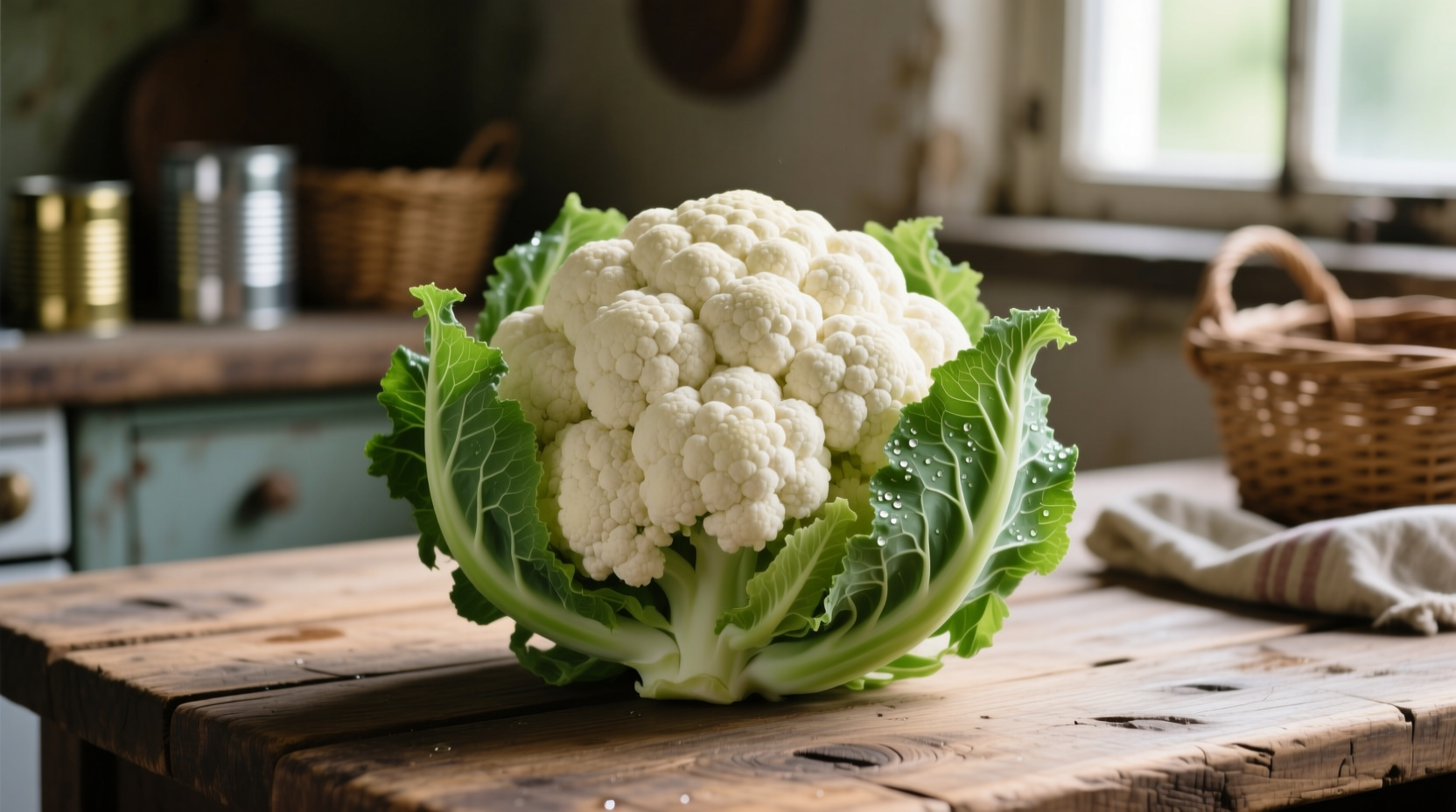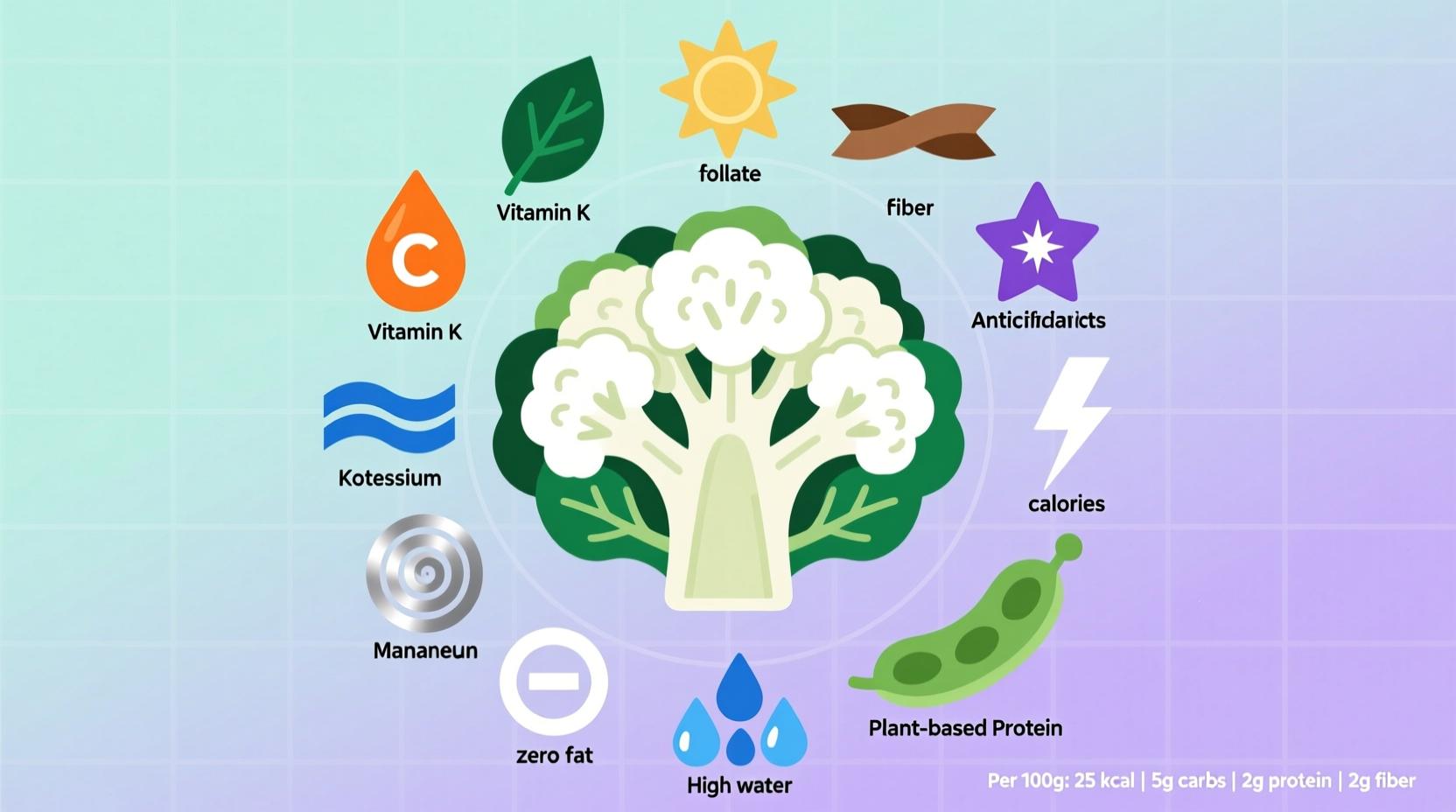One cup (100g) of raw cauliflower provides just 25 calories while delivering 77% of your daily vitamin C needs, 20% of vitamin K, and 20% of folate. This cruciferous vegetable is exceptionally rich in fiber, antioxidants, and cancer-fighting compounds like sulforaphane, making it a nutritional powerhouse with significant benefits for heart health, digestion, and inflammation reduction.
Discover why nutritionists consistently rank cauliflower among the top functional foods for optimal health. Whether you're managing weight, boosting immunity, or seeking disease prevention strategies, understanding cauliflower's complete nutritional profile reveals why this versatile vegetable deserves regular rotation in your meal planning.
Core Nutritional Profile: What's Inside Every Bite
When evaluating what is the nutritional value of cauliflower, start with the fundamental macronutrient composition. A standard 100-gram serving (about 3.5 ounces) of raw cauliflower contains:
| Nutrient | Amount per 100g | % Daily Value* |
|---|---|---|
| Calories | 25 kcal | 1% |
| Carbohydrates | 5 g | 2% |
| Dietary Fiber | 2 g | 7% |
| Protein | 1.9 g | 4% |
| Total Fat | 0.3 g | 0% |
| Water Content | 92 g | N/A |
*Percent Daily Values based on a 2,000 calorie diet. Source: USDA FoodData Central
This remarkably low-calorie density makes cauliflower an excellent choice for weight management while providing substantial volume and satisfaction. The high water content contributes to hydration, while the fiber content supports digestive health without causing blood sugar spikes common with starchy vegetables.
Vitamin Powerhouse: Essential Micronutrients Revealed
Understanding cauliflower nutrition facts per 100g requires examining its exceptional vitamin profile. This cruciferous vegetable delivers impressive concentrations of vital nutrients:
- Vitamin C: 48.2 mg (77% DV) - Crucial for immune function, collagen synthesis, and antioxidant protection. One cup provides more vitamin C than an orange.
- Vitamin K: 15.5 µg (20% DV) - Essential for blood clotting and bone metabolism. Critical for maintaining bone density as we age.
- Folate (B9): 57 µg (14% DV) - Vital for DNA synthesis and particularly important during pregnancy for fetal development.
- Vitamin B6: 0.2 mg (10% DV) - Supports brain health and neurotransmitter production.
- Choline: 17.8 mg (3% DV) - Often overlooked nutrient essential for liver function and brain development.
According to research published in the Journal of Food Science and Technology, cauliflower contains higher concentrations of certain antioxidants than its cruciferous cousins like broccoli when measured by serving size. This makes it particularly valuable for combating oxidative stress.
Mineral Content: Beyond the Basics
While vitamins often steal the spotlight when discussing what is the nutritional value of cauliflower, its mineral composition deserves attention. Per 100g serving:
- Potassium: 299 mg (6% DV) - Essential electrolyte that helps regulate blood pressure and fluid balance
- Manganese: 0.15 mg (7% DV) - Important for bone formation and metabolic function
- Magnesium: 15 mg (4% DV) - Involved in over 300 enzymatic reactions in the body
- Calcium: 22 mg (2% DV) - Contributes to bone health, though not as concentrated as in dairy
- Phosphorus: 44 mg (4% DV) - Works with calcium for bone strength
These minerals work synergistically with cauliflower's vitamin content to support cardiovascular health. The American Heart Association recognizes cruciferous vegetables like cauliflower as part of heart-healthy dietary patterns due to their potassium content and anti-inflammatory properties.
Phytonutrients and Bioactive Compounds: The Hidden Superpowers
The true nutritional distinction of cauliflower lies in its unique phytochemical profile. These compounds provide health benefits beyond basic nutrition:
- Glucosinolates: Sulfur-containing compounds that convert to isothiocyanates when chopped or chewed. Research from the National Cancer Institute shows these may help protect against certain cancers by supporting detoxification pathways.
- Sulforaphane: Particularly abundant in cauliflower, this compound has demonstrated anti-inflammatory and antioxidant effects in multiple studies.
- Indole-3-carbinol: Forms when cauliflower is cooked, potentially supporting hormone balance.
- Carotenoids: Including beta-carotene (in orange cauliflower varieties) and lutein for eye health.
These bioactive compounds explain why nutritionists emphasize cauliflower health benefits beyond basic nutrition. The concentration of these compounds varies based on growing conditions and preparation methods, which we'll explore next.

Maximizing Nutrient Retention: Cooking Methods Compared
How you prepare cauliflower significantly impacts its nutritional value. Research from the International Journal of Food Science reveals how different cooking techniques affect nutrient retention:
| Cooking Method | Vitamin C Retention | Glucosinolate Retention | Best For |
|---|---|---|---|
| Raw | 100% | 100% | Maximum nutrient preservation |
| Steaming (5 min) | 85-90% | 70-80% | Best balance of texture and nutrition |
| Roasting (20 min) | 60-70% | 50-60% | Enhanced flavor development |
| Boiling (10 min) | 40-50% | 30-40% | Avoid for maximum nutrition |
| Stir-frying (5 min) | 75-85% | 60-70% | Quick preparation with good retention |
For optimal nutrient preservation, chop cauliflower and let it sit for 5-10 minutes before cooking. This allows myrosinase enzymes to activate and maximize sulforaphane formation. Pairing cauliflower with black pepper or mustard seed powder can further enhance sulforaphane availability, according to research in the Journal of Agricultural and Food Chemistry.
Health Benefits: Science-Backed Advantages
Understanding what is the nutritional value of cauliflower becomes meaningful when connecting nutrients to health outcomes. Evidence-based benefits include:
Digestive Health Support
The 2g of fiber per 100g serves as prebiotic fuel for beneficial gut bacteria. Unlike some high-fiber foods that cause bloating, cauliflower's soluble fiber content makes it generally well-tolerated. The University of Michigan Health System notes that cruciferous vegetables like cauliflower support regular bowel function without excessive gas production when introduced gradually.
Cardiovascular Protection
Cauliflower's combination of fiber, potassium, and antioxidant compounds contributes to heart health. A 2020 meta-analysis in Nutrients found that higher cruciferous vegetable intake correlated with 15.6% lower risk of cardiovascular disease. The fiber helps manage cholesterol levels while potassium supports healthy blood pressure.
Inflammation Reduction
Chronic inflammation underlies many diseases. Cauliflower's vitamin C, K, and sulforaphane work synergistically to reduce inflammatory markers. Research in the Journal of Inflammation Research demonstrates that sulforaphane inhibits key inflammatory pathways at the cellular level.
Cancer Prevention Potential
While not a treatment, cauliflower's glucosinolates show promise in cancer prevention research. The American Institute for Cancer Research classifies cruciferous vegetables as foods that "probably" decrease cancer risk, particularly for digestive tract cancers. Population studies suggest regular consumption may reduce risk by 15-20%.
Seasonal and Color Variations: Nutritional Differences
Not all cauliflower is nutritionally identical. Understanding these variations helps maximize benefits:
- White Cauliflower: Most common variety, excellent vitamin C and K source
- Orange Cauliflower: Contains beta-carotene (converts to vitamin A), providing additional antioxidant benefits
- Purple Cauliflower: Rich in anthocyanins (same antioxidants in blueberries), offering enhanced anti-inflammatory effects
- Green Cauliflower (Romanesco): Higher in certain carotenoids and vitamin E compared to white varieties
Seasonality also affects nutritional content. Fall-harvested cauliflower typically contains higher concentrations of glucosinolates than spring crops, according to agricultural research from the University of California. For maximum nutritional value, choose locally grown, in-season cauliflower when possible.
Practical Incorporation: Making Cauliflower Work for You
Knowing cauliflower nutritional information for weight loss matters only if you can practically incorporate it. Here are evidence-based strategies:
- Rice Substitute: Pulse raw cauliflower in a food processor for a low-carb alternative that provides 90% fewer carbs than white rice
- Pizza Crust: Combine riced cauliflower with egg and cheese for a high-protein, nutrient-dense base
- Creamy Sauces: Blend steamed cauliflower with garlic and nutritional yeast for dairy-free "cheese" sauce
- Roasted Snacks: Toss florets with olive oil and spices for nutrient-dense chips
- Smoothie Booster: Add raw cauliflower to smoothies for extra nutrients without altering flavor significantly
Nutritionists recommend consuming cauliflower 2-3 times weekly to gain maximum benefits while maintaining dietary variety. Pairing with healthy fats like olive oil enhances absorption of fat-soluble vitamins and phytochemicals.
Frequently Asked Questions
How does cauliflower compare nutritionally to broccoli?
While both are cruciferous vegetables, cauliflower contains slightly more vitamin C (48.2mg vs 36.6mg per 100g) and comparable fiber. Broccoli has more vitamin K and vitamin A, while cauliflower provides more choline. Both contain similar glucosinolate profiles, though specific concentrations vary. Cauliflower generally has fewer calories (25 vs 34 per 100g) and less sugar than broccoli.
Is cauliflower good for weight loss?
Yes, cauliflower is excellent for weight management. With only 25 calories per 100g and high water content, it provides substantial volume with minimal calories. Its 2g of fiber per serving promotes satiety, helping reduce overall calorie intake. Many use it as a low-calorie substitute for higher-carb foods like rice, potatoes, and flour in various recipes.
Does cooking cauliflower destroy its nutrients?
Cooking does affect some nutrients, but strategic preparation preserves most benefits. Boiling causes the most nutrient loss (up to 60% for vitamin C), while steaming retains 85-90%. Raw cauliflower provides maximum nutrients, but light cooking actually increases availability of certain compounds like indole-3-carbinol. For best results, steam for 5 minutes or less, or enjoy raw in salads and dips.
Can you eat too much cauliflower?
While generally safe, excessive cauliflower consumption (more than 2-3 cups daily) may cause digestive discomfort in some people due to its raffinose content, a complex sugar that can cause gas. Those on blood thinners should monitor intake due to vitamin K content, and individuals with thyroid conditions may want to moderate raw cruciferous vegetable consumption. For most people, regular moderate consumption presents no issues.
What's the best way to store cauliflower to preserve nutrients?
Store whole cauliflower heads stem-side down in a perforated plastic bag in the refrigerator's crisper drawer. This maintains humidity while allowing airflow. Properly stored, it retains nutrients for 1-2 weeks. Avoid washing before storage, as excess moisture accelerates spoilage. Cut florets should be stored in an airtight container with a paper towel to absorb moisture and used within 4-5 days for maximum nutrient retention.











 浙公网安备
33010002000092号
浙公网安备
33010002000092号 浙B2-20120091-4
浙B2-20120091-4